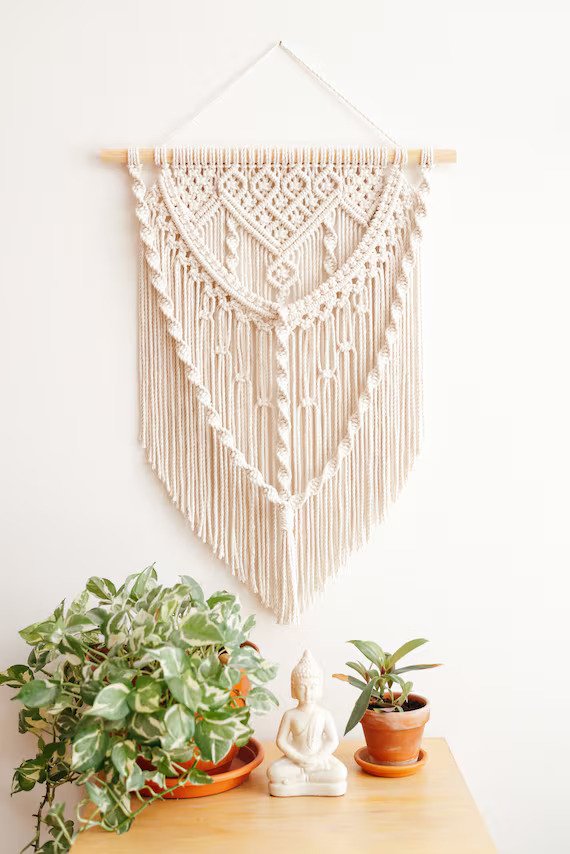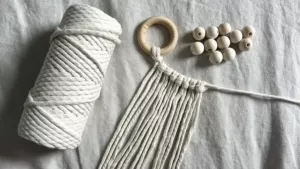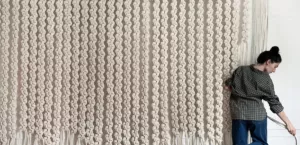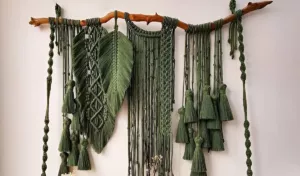Macrame is a type of textile art that uses knotting techniques to create decorative patterns and designs. The word “macrame” comes from the Turkish word “makrama”, meaning fringe or tassel.
The art of macrame dates back centuries, with early examples found in 13th century Arabic weavings. It became popular in Europe in the 17th and 18th centuries as a decorative craft for making household items like tablecloths, curtains, and bedspreads.
In the 1970s, macrame experienced a revival in popularity as a hobby and art form. Macrame wall hangings became a staple decorative item during this bohemian, craft-loving decade. The most common macrame wall hanging designs from the 70s include the owl, the spider web, the square, and the diamond.
Today, macrame remains a popular fiber art technique. Crafters use a variety of knotting and braiding methods to create beautiful, artistic hangings that add texture and visual interest to any space. The handmade quality and one-of-a-kind designs make macrame wall hangings special statement pieces.
Supplies Needed
Macrame art requires some basic supplies to get started. The most essential supply is cord, which comes in various materials, sizes, and colors.
Cords
- Cotton cords are one of the most popular options. They have a soft, textured feel and come in different sizes like 3mm, 4mm, 5mm, etc. Cotton is great for beginners.
- Jute has an organic, rustic aesthetic. Jute cords can be quite thick, like 4mm to 8mm. Keep in mind that jute can be rough on hands.
- Nylon cords have a smooth, silky finish and sheen. Nylon comes in 2mm to 6mm thickness. It’s super strong and won’t fray.
- Hemp and bamboo cords are eco-friendly options. Hemp has a coarse, natural feel while bamboo is soft and silky. Both work well for macrame.
In general, thinner cords, like 2-3mm, are best for delicate pieces with lots of knots and details. Thicker cords, like 6-8mm, are ideal for chunky statement pieces. Mixing multiple cord thicknesses in one project creates visual interest.
Findings
- Metal rings in various sizes act as the base to start knotting the cords onto. Brass, copper, and aluminum are common.
- Wood or metal dowels may be used too. Choose lengths from 6 inches to several feet.
- Beads add color and texture as decorative accents woven into the knots. Consider wood, glass, gemstone, clay beads.
- Scissors and clippers will be essential for cutting cords to size. Spring loaded scissors help avoid hand fatigue for larger projects.
- Clamps and clips help secure cords in place as you work. Alligator clips, binder clips, tape can all be handy workspace tools.
Aim for high-quality cords and findings for durability, though inexpensive supplies are fine for starters too. Gather a variety of cord types and thicknesses to allow creativity and experimentation with different macrame techniques.
Basic Knots
Macrame involves tying knots to create patterns and shapes. There are a few basic knots that are essential to learn when getting started with macrame.
Square Knot
The square knot is one of the most basic and versatile knots used in macrame. It is created by taking two cords and tying them in an overhand knot, then repeating with the opposite cords. This creates a flat, square-shaped knot. The square knot can be used to create straight lines and 90 degree angles in patterns. It is also useful for joining cords together.
Spiral Knot
The spiral knot forms a twisted cord and is achieved by tying a series of square knots at an angle. Each square knot is tied so it twists to the right or left to form the spiral shape. Spiral knots add interesting texture and three-dimensional shapes to macrame designs. They can be used as decorative edging or to make cords for hanging.
Half Hitch Knot
The half hitch is a simple knot created by wrapping one cord around another and pulling through. Half hitches are used to attach cords to a dowel or rod at the top of a macrame project. They allow cords to hang down from the dowel. Multiple half hitches can be stacked to create bars.
Lark’s Head Knot
The lark’s head knot is used to attach cords to a mounted dowel or rod. It is created by folding a cord in half to form a loop, then passing the loop over the dowel and pulling the ends through the loop. Lark’s head knots are useful for starting macrame projects.
Beginner Patterns
Macrame is a great craft for beginners because you can create beautiful pieces using just a few basic knots. Here are some of the most popular beginner macrame patterns to try:
Single Spiral
The single spiral is one of the simplest macrame patterns. You just repeat a series of half knots or square knots in a spiral shape. This creates a lovely twisted cord that makes a great plant hanger or wall decoration. Adjust the spacing between knots to create tighter or looser spirals.
Waves
The waves pattern involves making a series of half knots that move up and down like waves. Varying the height of the waves creates visual interest. For a wall hanging, make the waves go across the entire piece. For a plant hanger, make waves down the length of the cords.
Diamond
The diamond pattern utilizes square knots to create a geometric diamond design. Half knots fill in the spaces between the diamonds. Making several rows of diamonds creates a pretty lattice design. Diamonds work great as wall hangings, headboards, curtains, and more.
Owl
Macrame owl patterns use half knots to shape the eyes and wings of an owl. The body is made up of square knots. Add texture by tying knots with varying cord thicknesses. Owl patterns make delightful wall hangings and ornaments.
Heart
Hearts are a classic macrame motif for a reason – they are simple to make but look lovely. Position square knots to shape the heart. Fill in between with half knots or additional patterns. Heart wall hangings make wonderful gifts for loved ones.
Experiment with these fundamental beginner macrame patterns to learn the basic knots. Once you’ve mastered these designs, you’ll be ready to advance to more complex patterns. The possibilities are endless with macrame!
Intermediate Patterns
Macrame art is a fun way to learn new knots and patterns once you’ve mastered the basics. Moving onto intermediate patterns allows you to expand your skills and get more creative with your wall hangings. Some popular intermediate patterns to try are geometric shapes, landscapes, mandalas, and dreamcatchers.
Geometric Shapes
Geometric shapes like triangles, diamonds, hexagons, and octagons make for interesting macrame wall hangings. You can combine various shapes together in repeating patterns or make a statement piece with one large geometric focal point. Some key knots for geometric patterns are the square knot, spiral knot, and alternating half-hitch knot. Play around with knot placements and color combinations.
Landscapes
Bring nature indoors by creating macrame landscape wall hangings. These can depict trees, mountains, sunsets, forests, beaches, or any scene you’d like. Use variations in knot textures and multiple shades of thread to add depth and dimension. Try branching out from the standard square hanging shape with an organic, flowing silhouette. Landscapes allow you to really tell a story with your macrame art.
Mandalas
Mandalas are circular geometric designs that make for mesmerizing macrame projects. They often contain repetitive patterns radiating from a center point. Try alternating half-hitch knots in concentric circles, or combine spiral knots, square knots, and larks head knots for more elaborate mandalas. Use thread in rainbow colors or complementary shades for a vibrant effect. Mandalas can range from simple to extremely intricate based on your skill level.
Dreamcatchers
Dreamcatchers are a Native American tradition that can be adapted into macrame wall art. Though traditional dreamcatchers are round, you can play around with different shapes and sizes. Incorporate various knots like the double half-hitch and square knot to create a web-like design. Hang beads, feathers, and charms from the bottom for a finishing touch. Make a large statement dreamcatcher or a series of smaller ones.
The intermediate patterns above allow you to expand your skills into new techniques and shapes. Moving beyond beginner projects will let your creativity shine through. Don’t be afraid to experiment and find designs that speak to you personally. The possibilities are endless with macrame!
Advanced Patterns
Macrame art can be elevated to more advanced designs by incorporating shapes and figures. Once you have mastered the basic knots and patterns, you can begin to create more intricate wall hangings.
Human Figures
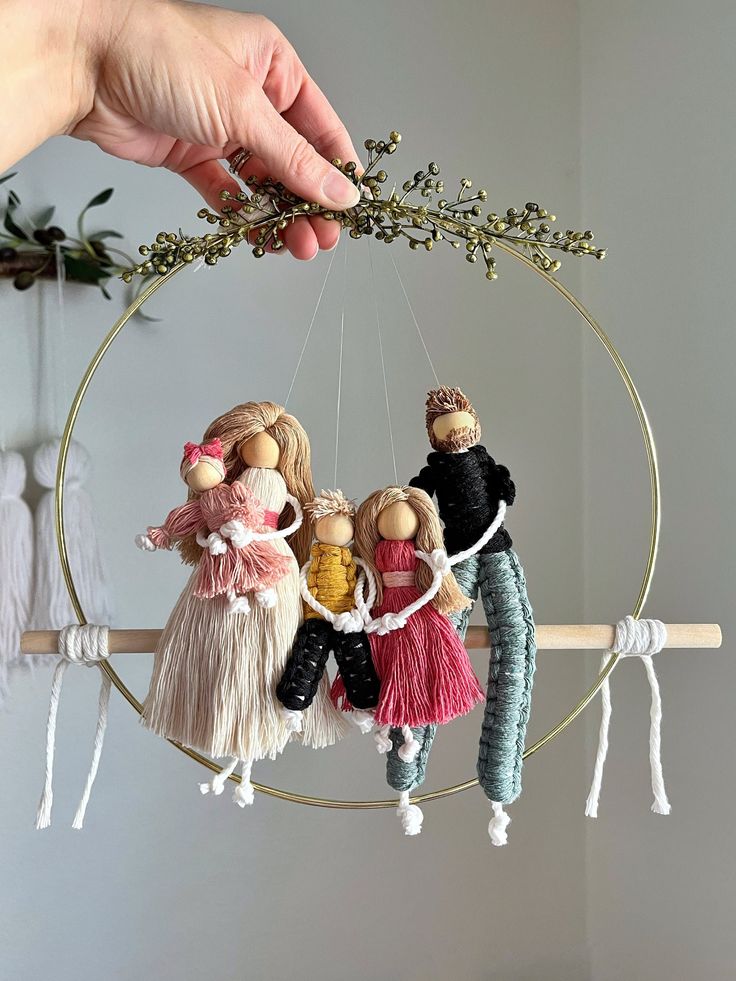
Crafting the shape of a human figure takes patience and practice. Start with a basic body shape using square knots. Add limbs using lark’s head knots and varying lengths of cord. Use half-hitch knots to define hands, feet, fingers, and toes. Play with different sizes and poses. For the head, coil cords into circles and secure with wrapping knots. Hairstyles can be made from various knot textures. Clothing is optional, using color cord or beads. A human figure macrame piece makes an interesting accent for a wall.
Animal Shapes
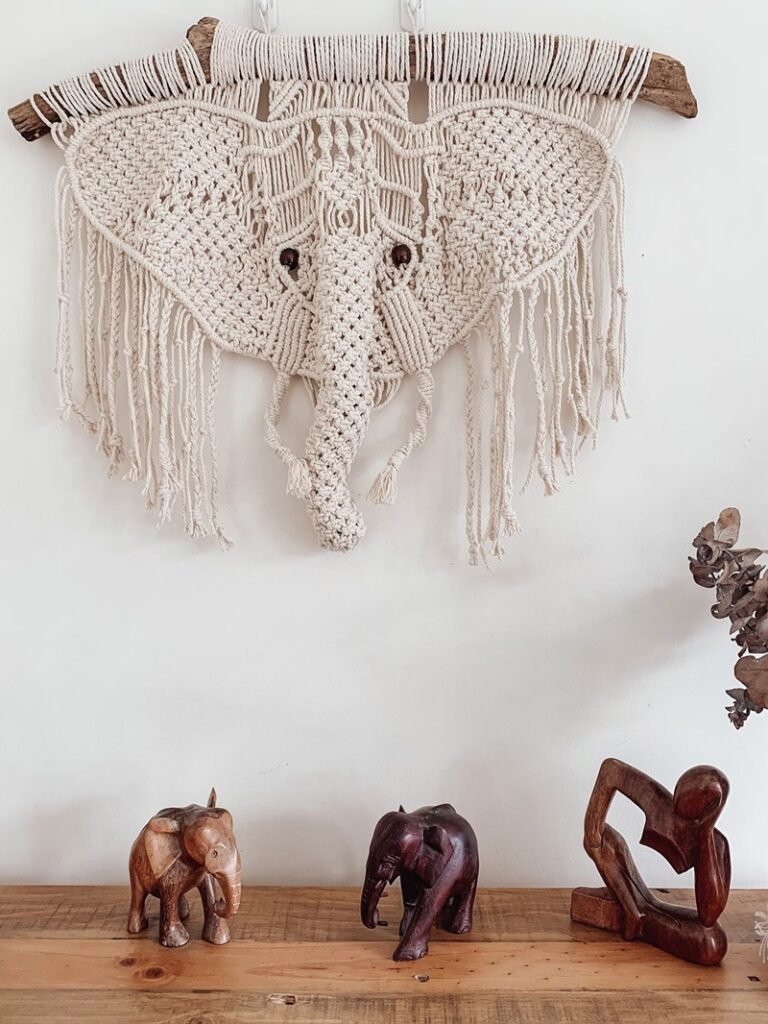
Animal shapes allow you to get creative with macrame knots. Simple shapes like birds, butterflies, and fish are beginner-friendly. Outline the body with square knots, adding detail with lark’s head and spiral knots. For more advanced animals like horses, elephants, or giraffes, plan the proportions carefully. Use half-hitch and wrapping knots for legs, tails, manes, and other details. Add color for stripes, spots, or other patterns. 3D sculptural effects can be achieved by carefully shaping and knotting the cords. An animal macrame piece livens up a child’s room or makes whimsical art for any space.
Abstract Wall Art
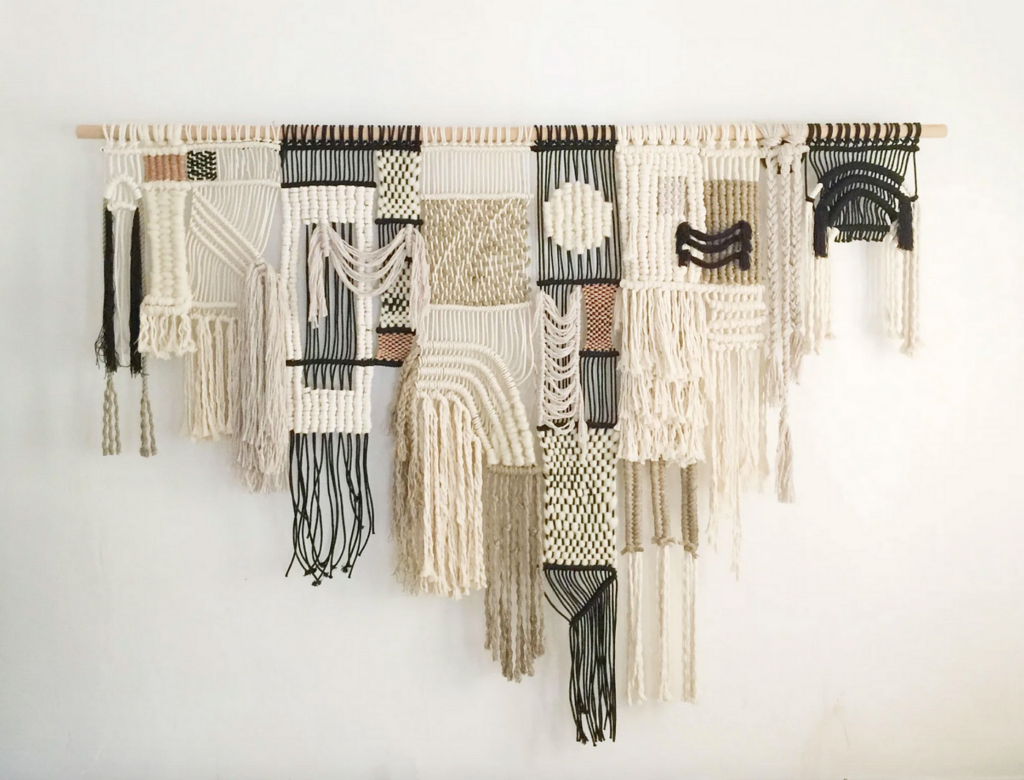
For modern, abstract wall art, play with different knot techniques and patterns. Combine knots like square, spiral and diamond to create geometric shapes and textures. Use varying cord sizes and multiple colors for visual interest. Plan out a pleasing composition and balance of elements. Abstract macrame art can be made into tapestries, panels, or sculptural pieces. Get creative with irregular shapes, multidimensional effects, and negative space. This allows for great artistic freedom. Display over a couch, bed, or dining area for a focal point full of color and texture. Abstract macrame makes a chic, on-trend statement.
With some practice, macrame can yield endless advanced creations for the wall. Let your imagination run wild, and don’t be afraid to experiment. A uniquely knotted piece reflects your personal style and artistry.
Adding Color and Texture
Macrame art can really stand out when you incorporate different colors, textures, and materials into your wall hangings. Here are some ideas for adding visual interest:
Using Different Cord Materials
- Cotton cord comes in a wide range of colors and thicknesses. Mixing up the colors and sizes can create striking designs and patterns.
- Jute cord has an earthy, natural look that works well for boho or farmhouse style pieces.
- Nylon cord is very strong and durable. It comes in glossy and matte finishes.
- Hemp cord has a rustic texture that knots well. Natural tan and ecru shades are common.
- Metallic cord includes gold, silver, copper and more. It can add a touch of glam and shine.
- Silk cord provides a luxurious drape and sheen. It’s available in solids and variegated colors.
- Leather cord gives a rugged, masculine vibe. Braided and twisted leather cords are options.
Mixing different cord materials in one project can look amazing. Just be sure to choose cords of similar thickness so they knot well together.
Incorporating Beads
Beads are a great way to punctuate macrame designs. They can be strung onto the cords or attached using basic knots.
- Wooden beads like oak, walnut and bamboo have natural appeal.
- Ceramic beads come glazed or unglazed in endless shapes and colors.
- Glass beads add a rainbow of hues, as well as metallic and iridescent options.
- Gemstone beads bring nature’s beauty, from smooth agate to faceted crystals.
- Shell beads in shapes like discs or tubes have organic, beachy style.
When adding beads, place them thoughtfully to enhance the overall look. Clustering beads can create an interesting focal point. Alternating beads with knots is another technique. Just take care not to make the wall hanging too heavy.
Hanging and Displaying Macrame Art
Macrame art looks best when properly displayed. Here are some tips for hanging and showcasing your macrame creations:
Securing Hangers and Hoops
- Use sturdy hangers and hoops to support the weight of your macrame art. Oversized metal rings work well for large wall hangings.
- For smaller pieces, opt for framed macrame hoops. Secure the macrame knots tightly around the inner hoop so the art stays taut when hung.
- Attach hangers and hoops to the macrame using strong thread, wire, or cord. Reinforce attachment points with extra knots if needed.
- Wide hangers distribute weight better than narrow ones. Place hangers at top and bottom of wall hangings for balance.
- For long vertical hangings, use a hanging rod through the top instead of hoops. Secure tightly and check rod is level.
Displaying on Walls
- Find a wall space wide enough to properly display your macrame art. Measure to center.
- Use screws and wall anchors rated for the weight of the art. Nails are not secure enough.
- For very heavy pieces, install a hanging wire instead of hooks. Or use adhesives like Command Strips.
- Make sure hangers or hooks are level so the macrame hangs straight. Adjust as needed.
- Allow extra length so the macrame does not rest directly on the floor. Leave several inches minimum.
- Light the wall hanging properly. Add accent lighting or position where sunlight hits for best effect.
- Display macrame art in entryways, bedrooms, living rooms, or as room dividers. Let it add natural texture.
Caring for Macrame
Macrame is relatively low maintenance, but there are some things to keep in mind when caring for your wall hangings to help them last.
Cleaning
- Use a soft brush like a paintbrush to gently remove any dust or debris. This is better than vacuuming, which can be too harsh.
- For more thorough cleaning, you can use a mild soap and warm water. Avoid harsh chemicals.
- Dampen a soft cloth with the soap mixture, then gently wipe down the macrame. Rinse with clean water and allow to fully dry before hanging again.
Preventing Damage
- Keep macrame out of direct sunlight, which can cause fading over time.
- Avoid hanging in high-humidity areas like bathrooms, as excess moisture can encourage mold growth.
- Be very gentle when handling to avoid snagging or pulling knots loose.
Storing
- If storing macrame for a period of time, keep it in a cool, dry place out of direct light.
- Carefully roll up or fold the macrame to prevent tangles and knots. Place acid-free tissue between folds.
- Store in a breathable bag or box, not plastic which could trap moisture.
- Avoid wire hangers which could stretch or distort the shape over time. Use a padded hanger.
- Periodically check on stored macrame and refold or reshape as needed.
Inspiration and Ideas
Macrame art has seen a resurgence in popularity over the last few years, with creative artists and interior designers finding new and innovative ways to use this fiber art form. From minimalist wall hangings to lush bohemian tapestries, there is no limit to where macrame can provide visual interest.
Some standout macrame artists to follow for inspiration include:
- Janet Mia Foley – Known for nature-inspired hangings featuring detailed realistic leaves and branches. Her pieces evoke a sense of wandering through a magical forest.
- Torie Nguyen – Specializes in abstract geometric designs, often using gradients of color to create focal points. Her modern minimalist style results in hypnotic wall hangings.
- Rachel Green – Brings a bohemian flavor using beads, tassels, and a rich color palette. She often incorporates found and repurposed materials like driftwood and vintage textiles.
- Erin Hunting – Creates dreamy celestial-themed hangings depicting moons, stars, and galaxies. Metallic cords and glittering beads add galaxy-like sparkle.
Macrame has also been embraced by interior designers for adding natural texture to living spaces. Some ways they’ve incorporated it include:
- Room dividers or wall hangings over sofas/beds
- Decorative swags over windows and doorways
- Macrame tapestries used as headboards
- Plant hangers displayed on porches or patios
- Chair decor such as macrame poufs or backrests
There are endless possibilities for where macrame art can enhance a room’s aesthetic. Browse interior design sites, museums, art fairs, Etsy, and Instagram for new ideas and perspectives on working with this fiber craft. The organic beauty of macrame can elevate any living space.

